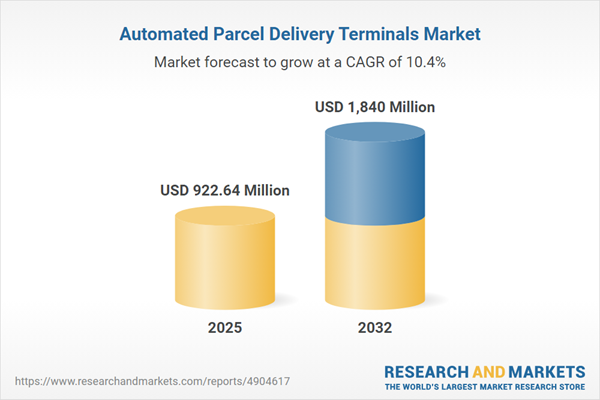Speak directly to the analyst to clarify any post sales queries you may have.
Automated parcel delivery terminals are accelerating transformation in last-mile logistics, enabling enterprises to enhance operational agility and address evolving customer and compliance demands. These advanced solutions form a critical component of modern logistics strategy, supporting efficiency and resilience for organizations in rapidly advancing markets.
Market Snapshot: Automated Parcel Delivery Terminals Market Growth
The automated parcel delivery terminals market is advancing at a compound annual growth rate (CAGR) of 10.37% through 2032. Substantial momentum is fueled by ongoing digital transformation and logistics modernization efforts across global regions. As enterprises adopt these terminals, they drive the expansion of automation, address the ongoing rise of e-commerce, and respond to increasing consumer preference for contactless delivery models. Heightened investor interest stems from the sector’s role in delivering higher service reliability and supporting adaptation to new regulatory dynamics in a competitive landscape.
Scope & Segmentation: Automated Parcel Delivery Terminals Market
This report delivers clear guidance for senior executives focused on informed investment and risk-mitigation strategies, drawing from a granular analysis of market segments and critical technological advances.
- Component: Integrated electronic locker hardware equipped with robust access controls and partnered with management software and analytics ensures secure, streamlined operations for enterprise needs. Service offerings include full-scope installation and routine maintenance to guarantee consistent uptime and enterprise-grade security protocols.
- Package Size: Solutions effectively handle a range of parcel dimensions, from compact packets to larger consignments, meeting the fulfillment needs of retail, distribution, and other intricate sectors.
- Functionality: Automated terminals manage parcel pick-up, drop-off, and returns, optimizing daily supply chain cycles and improving user convenience at all operational stages.
- Deployment: Indoor and weather-resistant outdoor units are tailored for various site requirements, ensuring flexible integration and compliance with enterprise security standards.
- Application Type: Industries such as e-commerce, logistics, healthcare, and retail leverage these terminals to meet distinct industry performance targets, compliance requirements, and operational objectives.
- Geographic Regions: The market spans the Americas, Europe, Middle East and Africa, and Asia-Pacific, shaped by unique local regulations, standards, and supply chain priorities across key economies including the United States, Germany, China, and India.
- Leading Companies: Key providers such as ParcelHive, SwipBox A/S, Bell and Howell LLC, Parcel Pending LLC, Florence Corporation, Cleveron AS, Smartbox Ecommerce Solutions Private Ltd, KEBA Group AG, InPost sp. z o.o., and Winnsen Industry Co., Ltd. continue to drive innovation, forming new partnerships and advancing enterprise offerings through progressive technologies.
Key Takeaways for Senior Decision Makers
- Automated parcel delivery terminals support improved operational reliability, visibility, and fulfillment accuracy, enhancing executive control across logistics processes and facilitating robust risk management protocols.
- Incorporation of IoT and artificial intelligence delivers predictive analytics and actionable insights, enabling proactive maintenance and empowering organizations to scale efficiently as operational requirements change.
- Temperature-controlled modules extend usability to sectors like healthcare and food, aligning with stringent compliance and process integrity standards in high-value supply chains.
- Sustainable product design assists organizations in meeting environmental regulations and corporate sustainability goals, minimizing footprint across deployment and continued operation.
- API-enabled architecture ensures seamless connection with existing enterprise systems, accelerating digital transformation and enhancing multi-stage supply chain visibility and transparency.
Tariff Impact: Navigating Changing Global Trade Dynamics
Anticipated revisions to United States tariffs in 2025 are leading enterprises to adjust procurement and sourcing strategies for automated parcel delivery terminals. Organizational resilience is fortified through diversified supplier networks, exploration of regional vendors, and formation of strategic technology alliances. These responses support flexible pricing models and protect against shifting international trade and regulatory demands, while contributing to a more resilient supply chain ecosystem.
Methodology & Data Sources
This research integrates direct interviews with executives across manufacturing, retail, and logistics, supported by the expertise of regulatory specialists. Proprietary data models and rigorous analysis of recent intellectual property trends underpin the credibility and relevance of findings provided to C-level decision makers.
Why This Report Matters
- Aligns investment and compliance strategies to proactively manage emerging supply chain risks in the automated parcel delivery terminals market.
- Delivers accurate segmentation and in-depth regional analysis for executives to tailor business and compliance actions to organizational objectives.
- Supports supplier evaluation and partnership selection to strengthen resilient infrastructure and strategic supply chain planning.
Conclusion
Senior leaders can leverage this analysis to shape robust automated parcel delivery terminal strategies, reinforce logistics infrastructure, and achieve operational continuity in dynamic, evolving global markets.
Additional Product Information:
- Purchase of this report includes 1 year online access with quarterly updates.
- This report can be updated on request. Please contact our Customer Experience team using the Ask a Question widget on our website.
Table of Contents
3. Executive Summary
4. Market Overview
7. Cumulative Impact of Artificial Intelligence 2025
Companies Mentioned
The companies profiled in this Automated Parcel Delivery Terminals market report include:- ParcelHive
- SwipBox A/S
- Bell and Howell LLC
- Parcel Pending LLC.
- Florence Corporation
- Cleveron AS
- Smartbox Ecommerce Solutions Private Ltd
- KEBA Group AG
- InPost sp. z o.o.
- Winnsen Industry Co., Ltd
Table Information
| Report Attribute | Details |
|---|---|
| No. of Pages | 189 |
| Published | October 2025 |
| Forecast Period | 2025 - 2032 |
| Estimated Market Value ( USD | $ 922.64 Million |
| Forecasted Market Value ( USD | $ 1840 Million |
| Compound Annual Growth Rate | 10.3% |
| Regions Covered | Global |
| No. of Companies Mentioned | 11 |









